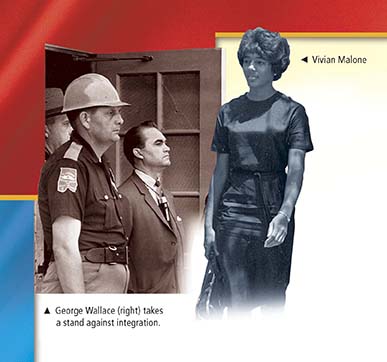SECTION 2: The Movement Gains Ground

WITNESS HISTORY  AUDIO
AUDIO
Blocking the Schoolhouse Door
Alabama governor George Wallace made it clear where he stood on civil rights: “I say segregation now! Segregation tomorrow! Segregation forever!” Wallace vowed to stand “in the schoolhouse door” and personally block any attempt to integrate Alabama schools. On June 11, 1963, he got his chance. As federal marshals escorted two African American students to register at the University of Alabama, Wallace stood on the steps of the school. He proclaimed the right of states to regulate their own schools. One of the students later recalled:
“I didn’t feel I should sneak in. I didn’t feel I should go around the back door. If [Wallace] were standing in the door, I had every right in the world to face him and to go to school.”
—Vivian Malone Jones, 2003
Objectives
- Describe the sit-ins, freedom rides, and the actions of James Meredith in the early 1960s.
- Explain how the protests at Birmingham and the March on Washington were linked to the Civil Rights Act of 1964.
- Summarize the provisions of the Civil Rights Act of 1964.
Terms and People
- sit-in
- SNCC
- freedom ride
- James Meredith
- Medgar Evers
- March on Washington
- filibuster
- Civil Rights Act of 1964
NoteTaking
Reading Skill: Summarize Use a concept web like the one below to record information about the civil rights protests of the 1960s.
Why It Matters Despite the Brown decision and other civil rights victories, little changed in the everyday lives of most African Americans. Nonetheless, activists continued to struggle for civil rights. In the early 1960s, the movement experienced a groundswell of support. This surge produced a dramatic shift in race relations, led to the passage of landmark civil rights legislation in 1964, and set the stage for future reforms. Section Focus Question: How did the civil rights movement gain ground in the 1960s?
Student Activists Make a Difference
After the Brown decision, many black youths expected that their schools would integrate quickly and that other racial reforms would follow. Change was not quick to come, however. Disappointed by the lack of progress, young African Americans began to challenge segregation with new vigor and determination.
Sit-ins Challenge Segregation
On February 1, 1960, four African American college students ordered doughnuts and coffee at a Woolworth’s lunch counter in Greensboro, North Carolina. As they expected, the white waitress refused to serve them. In the South, nearly all restaurants that served whites refused to serve blacks. To protest this discrimination, the four students sat down on the stools at the lunch counter, where they stayed until closing time.
Word of the Greensboro sit-in spread rapidly, sparking a wave of similar protests across the nation. In Nashville, Tennessee, for instance, students led by the Reverend James Lawson staged sit-ins





